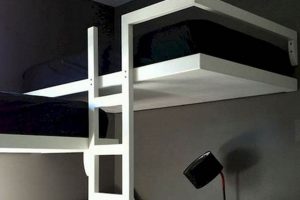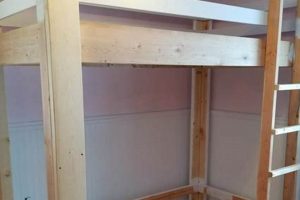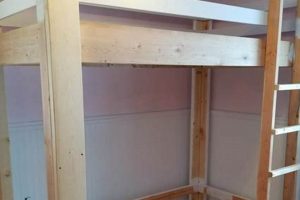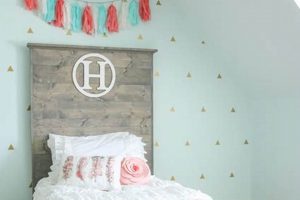A self-assembled storage bed with a nautical design incorporates drawers and compartments built into the base, maximizing space utilization, particularly in smaller rooms. This type of bed frame, often elevated for increased storage capacity, provides a practical solution for organization. An example includes a twin-sized bed frame constructed from plywood and featuring six under-bed drawers.
The appeal of constructing such a bed lies in its ability to combine sleeping arrangements with built-in storage, addressing spatial limitations and decluttering living areas. Historically, similar designs have been employed in maritime settings where space is at a premium, influencing the stylistic elements of the furniture. The customizability afforded through self-construction allows for personalization to meet specific needs and aesthetic preferences, offering a cost-effective alternative to purchasing pre-made storage beds.
The following sections will explore detailed instructions, design considerations, and material selection processes involved in undertaking such a project. Furthermore, safety precautions and relevant woodworking techniques will be addressed to ensure a successful and structurally sound finished product.
Construction Advice
The following guidance provides essential considerations for the successful creation of a self-assembled storage bed. These suggestions aim to enhance structural integrity, functionality, and aesthetic appeal.
Tip 1: Prioritize Structural Integrity: Employ high-quality lumber and ensure proper joint construction. Reinforce corners with metal brackets and use wood glue in conjunction with screws for maximum stability.
Tip 2: Plan for Weight Distribution: Account for the weight of the mattress and occupants when designing the bed frame. Distribute weight evenly across the support structure to prevent sagging or collapse. Additional support beams may be necessary, particularly for larger beds.
Tip 3: Optimize Drawer Mechanisms: Utilize full-extension drawer slides to maximize accessibility to stored items. Consider soft-close mechanisms to prevent slamming and reduce wear on the drawers and frame.
Tip 4: Design for Accessibility: Plan the placement and dimensions of drawers and compartments with user accessibility in mind. Ensure sufficient clearance for opening and closing drawers, considering the surrounding environment.
Tip 5: Implement Safety Measures: Round off sharp edges and corners to minimize the risk of injury. Secure all hardware properly and conduct thorough inspections to identify and rectify any potential hazards.
Tip 6: Finish with Durability in Mind: Apply a durable finish, such as polyurethane or varnish, to protect the wood from moisture, scratches, and wear. Consider the impact of chosen finishes on indoor air quality.
Tip 7: Accurately Measure and Cut: Precision is paramount. Double-check all measurements before cutting materials to ensure accurate assembly and a professional finish. Utilize appropriate cutting tools for clean and precise results.
Adhering to these recommendations will contribute to a robust, functional, and aesthetically pleasing result, optimizing the benefits of a space-saving sleep solution.
With these considerations addressed, the user can proceed with the construction, anticipating a rewarding outcome.
1. Space Optimization
The design and construction of a self-assembled storage bed are fundamentally linked to the principle of space optimization. The inherent purpose of integrating storage directly into the bed frame stems from a need to maximize usable area, particularly in environments where square footage is limited. The effect of this integration is a dual-purpose furnishing that consolidates sleeping and storage functions, thereby reducing the need for additional furniture pieces such as dressers or chests of drawers. The practical significance of this lies in its capacity to declutter living spaces, creating a more organized and efficient environment.
The configuration of the storage elements is critical. Drawer placement, compartment size, and access points are all variables that determine the degree of optimization achieved. For example, drawers located on both sides of the bed facilitate access from either side of the room, while incorporating vertical shelving within the headboard can provide additional storage for books or personal items. The height of the bed frame also plays a role; a taller frame provides more storage volume but may present accessibility challenges for some users. A well-designed storage bed effectively leverages these design parameters to provide a tailored storage solution that minimizes wasted space.
In summary, the relationship between space optimization and the construction of a storage bed is one of direct cause and effect. The need for efficient space utilization drives the design, while careful planning and execution determine the degree to which that optimization is achieved. The practical benefits extend to improved organization, decluttered living environments, and the efficient consolidation of essential functions. Challenges may arise in balancing storage capacity with accessibility and aesthetic considerations, but these can be mitigated through thoughtful design and careful construction.
2. Structural Integrity
The connection between structural integrity and a self-assembled storage bed is paramount. Structural integrity, in this context, refers to the capacity of the bed frame to withstand applied loads without deformation or failure. The cause-and-effect relationship is evident: inadequate structural design or construction directly leads to a compromised bed frame, potentially resulting in collapse or instability. The importance of structural integrity as a component of this type of bed cannot be overstated; it is the fundamental attribute ensuring safety and longevity. A real-life example involves a poorly constructed frame utilizing insufficient support beams that subsequently sags under the weight of the mattress and occupants, rendering the bed unusable and potentially hazardous. The practical significance of understanding this relationship lies in the ability to proactively mitigate risks through informed design and construction practices.
Further analysis reveals that several factors contribute to the overall structural soundness. These include material selection, joint construction techniques, and load distribution strategies. Solid wood frames, when properly joined using methods such as mortise and tenon or dovetail joints, exhibit greater strength and resistance to deformation compared to frames constructed from particleboard or improperly fastened materials. The implementation of strategically placed support beams, particularly in larger bed frames, is crucial for distributing weight evenly and preventing localized stress concentrations. Correctly fastened metal brackets can also significantly reinforce joints, enhancing their load-bearing capacity. Neglecting any of these factors can compromise the overall stability, irrespective of the aesthetic appeal.
In summary, the relationship between structural integrity and a self-assembled storage bed is critical for ensuring safe and long-lasting functionality. Key insights include the necessity of utilizing high-quality materials, employing robust joint construction techniques, and implementing effective load distribution strategies. Challenges may arise in balancing cost considerations with structural requirements; however, prioritizing structural integrity remains essential. This aspect, when properly addressed, ensures the bed can safely fulfill its intended purpose, effectively merging sleeping space with storage capacity.
3. Material Selection
Material selection directly influences the durability, stability, and aesthetic appeal of a self-assembled storage bed. The choices made dictate the long-term performance and structural integrity of the completed project. Using inappropriate or substandard materials will inevitably lead to premature failure, compromising the bed’s functionality and safety. An example is the use of thin, low-density particleboard for the frame, which may result in sagging or breakage under load. The significance of understanding the relationship between material properties and the intended application is critical for successful construction and optimal bed lifespan.
A comprehensive assessment of material options considers several factors. Solid hardwoods, such as oak or maple, offer superior strength and resistance to wear, making them suitable for the bed frame and load-bearing components. Softwoods, such as pine, are more affordable but may require additional reinforcement. Plywood, particularly Baltic birch plywood, provides a balance of strength and affordability, making it suitable for drawer boxes and non-structural elements. Medium-density fiberboard (MDF) is smooth and paintable but lacks the structural strength of solid wood or plywood. The selection process should also consider the environmental impact and potential off-gassing of certain materials. Proper material selection ensures the structural integrity and aesthetic appeal of the completed bed.
In summary, the informed selection of materials is paramount in the construction of a long-lasting and functional storage bed. Key insights include the recognition that different materials offer varying levels of strength, durability, and aesthetic appeal. Challenges may arise in balancing cost considerations with material performance requirements. However, prioritizing material quality is an investment in the longevity and safety of the project. The final result provides a sleep solution optimized for both storage and relaxation.
4. Customizable Design
The ability to tailor the design of a self-assembled storage bed constitutes a significant advantage, allowing for optimization based on individual needs and spatial constraints. This feature distinguishes it from mass-produced furniture, offering a level of personalization unattainable through standardized options.
- Dimensional Adaptation
Dimensional adaptation refers to the capability to modify the bed’s size and proportions to fit specific room dimensions. This includes adjusting the overall length, width, and height to accommodate unusual room layouts, low ceilings, or limited floor space. An example involves scaling the design to fit within an alcove, maximizing usable space that would otherwise remain unoccupied. This allows integration of the bed in a more seamless and efficient manner.
- Storage Configuration
Storage configuration encompasses the arrangement and dimensions of drawers, shelves, and compartments integrated into the bed frame. Customization allows for the specification of drawer depths, the inclusion of dividers, and the integration of specialized storage solutions, such as hidden compartments or pull-out desks. For instance, incorporating deeper drawers for storing bulky items or adding adjustable shelving for books enhances functionality. This approach maximizes storage based on the specific requirements of the user.
- Aesthetic Personalization
Aesthetic personalization allows for the selection of materials, finishes, and design elements to match the existing dcor or personal preferences. This includes choosing wood types, stains, paints, and hardware to create a cohesive and visually appealing piece of furniture. An example is selecting a specific wood stain to complement existing bedroom furniture or incorporating decorative hardware to enhance the bed’s overall style. Such details can significantly increase the overall value and satisfaction.
- Ergonomic Considerations
Ergonomic considerations address the comfort and accessibility of the bed frame. This involves adjusting the bed height to facilitate easy entry and exit, incorporating features such as rounded edges to minimize the risk of injury, and designing storage elements that are easily accessible. An example is adjusting the bed height to accommodate individuals with mobility limitations or incorporating recessed handles for easier drawer operation. This enhances usability and safety, demonstrating practicality.
These aspects of customizable design collectively enhance the practicality and value of the self-assembled storage bed. By tailoring the dimensions, storage configuration, aesthetics, and ergonomics, the finished product effectively meets individual needs and preferences, resulting in a more functional and visually appealing piece of furniture. The ability to adapt the design promotes efficiency.
5. Cost-Effectiveness
The economic advantages associated with constructing a self-assembled storage bed represent a primary motivator for many individuals. The appeal lies in the potential for significant cost savings when compared to purchasing a comparable, pre-fabricated unit. This section examines the constituent elements that contribute to this economic benefit.
- Reduced Labor Costs
The elimination of labor expenses inherent in factory production and retail assembly constitutes a significant cost reduction. By undertaking the construction, the individual assumes the role of the laborer, effectively circumventing the mark-up associated with professional assembly services. A real-world illustration involves comparing the cost of raw materials for a self-assembled unit versus the retail price of an equivalent pre-built bed. This difference frequently reflects the embedded labor expenses.
- Direct Material Procurement
Direct sourcing of raw materials allows for greater control over material selection and pricing. Bypassing retail markups on pre-built furniture enables the individual to purchase lumber, hardware, and finishing materials at wholesale or discounted rates. Examples include purchasing lumber directly from a mill or utilizing reclaimed materials to further reduce expenses. Such practices can significantly lower the overall project cost.
- Elimination of Retail Overhead
Self-assembly eliminates the costs associated with retail operations, including showroom expenses, sales commissions, and transportation logistics. These overhead costs are typically factored into the retail price of furniture. By avoiding these expenses, the individual effectively reduces the overall cost of acquiring a functional and aesthetically pleasing bed frame. The magnitude of these savings can be substantial, particularly for larger or more complex bed designs.
- Customization within Budget
Self-assembly allows for customization within budgetary constraints. The individual can prioritize material choices and design features based on available resources. For example, opting for less expensive wood species for non-structural components or simplifying the design to reduce material consumption can contribute to overall cost savings. The ability to adapt the design based on budgetary limitations enhances the economic viability of the project.
These aspects collectively underscore the economic advantages of a self-assembled storage bed. By eliminating labor costs, procuring materials directly, avoiding retail overhead, and customizing the design within budgetary constraints, individuals can achieve significant cost savings. The resulting bed offers a functional and aesthetically pleasing sleep solution at a fraction of the price of comparable retail alternatives, maximizing value and economic efficiency.
Frequently Asked Questions
The following questions address common concerns and misconceptions regarding the design, construction, and implementation of a self-assembled storage bed. These answers aim to provide clarity and promote informed decision-making.
Question 1: What is the typical cost range associated with constructing a self-assembled storage bed?
The total cost varies significantly depending on factors such as material selection, bed size, storage configuration complexity, and finishing techniques. A basic twin-sized frame constructed from pine may range from $200 to $400, while a queen-sized frame utilizing hardwood and incorporating intricate drawer systems could exceed $1000. Cost estimation requires a detailed bill of materials and accurate pricing information from local suppliers.
Question 2: What are the essential tools required for this woodworking project?
Essential tools include a circular saw or table saw for cutting lumber, a drill and impact driver for assembling the frame, a measuring tape and square for accurate layout, a sander for smoothing surfaces, and appropriate safety equipment such as eye protection and earplugs. Additional specialized tools, such as a router for creating decorative edges or a pocket-hole jig for concealed joinery, may enhance the quality and efficiency of the project.
Question 3: How is structural integrity ensured in a self-assembled storage bed?
Structural integrity relies on several key factors: the selection of high-quality lumber, the implementation of robust joint construction techniques (e.g., mortise and tenon, dovetail, or reinforced butt joints), the proper distribution of weight through strategically placed support beams, and the use of appropriate fasteners (e.g., screws, bolts, and wood glue). Regular inspection and maintenance are also essential to identify and address any potential weaknesses over time.
Question 4: What are the primary safety considerations during construction?
Safety considerations include wearing appropriate personal protective equipment (PPE), such as eye protection and hearing protection, when operating power tools. Ensuring adequate ventilation to avoid inhaling sawdust or finishing fumes is crucial. It is also essential to follow manufacturer’s instructions for all tools and materials and to exercise caution when handling heavy or bulky components. A clean and organized workspace minimizes the risk of accidents.
Question 5: What are the key factors to consider when designing the storage configuration?
Key factors include the intended use of the storage space, the dimensions of items to be stored, the accessibility of storage compartments, and the overall aesthetic design. Drawer placement should facilitate easy access from both sides of the bed, and compartment sizes should accommodate anticipated storage needs. Considerations should also be given to the weight distribution of stored items to prevent instability.
Question 6: What finishing options are recommended for a self-assembled storage bed?
Recommended finishing options include polyurethane, varnish, lacquer, and paint. Polyurethane provides a durable and water-resistant finish, while varnish offers a traditional aesthetic. Lacquer dries quickly and provides a smooth, hard surface. Paint allows for customization of color and style. The choice of finish should consider the desired aesthetic, the level of protection required, and potential environmental impact. Proper surface preparation, including sanding and priming, is essential for achieving a professional-looking finish.
In summary, these questions and answers provide essential guidance for those considering undertaking the construction of a self-assembled storage bed. Careful planning, attention to detail, and adherence to safety guidelines are crucial for a successful project.
The subsequent section will provide a step-by-step guide for constructing a basic storage bed frame, incorporating the principles outlined above.
DIY Captains Bed
This exploration of the self-assembled storage bed, commonly known as a “diy captains bed,” has illuminated several critical facets. The article highlighted the importance of structural integrity, the benefits of customizable design, and the potential for cost-effectiveness. Material selection and the optimization of storage space were also presented as key considerations. The project requires careful planning, precise execution, and adherence to safety protocols.
The information provided serves as a foundation for prospective builders. Individuals should thoroughly assess their skills, resources, and project requirements before commencing construction. The potential benefitsspace optimization, personalized design, and economic savingsare significant, but the undertaking demands diligence and commitment. The creation of a stable and functional sleep solution necessitates careful consideration of each element discussed.







